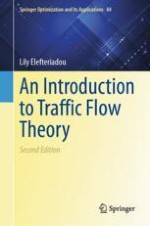2024 | OriginalPaper | Chapter
2. Modeling Vehicle Interactions and the Movement of Groups of Vehicles
Author : Lily Elefteriadou
Published in: An Introduction to Traffic Flow Theory
Publisher: Springer International Publishing
Activate our intelligent search to find suitable subject content or patents.
Select sections of text to find matching patents with Artificial Intelligence. powered by
Select sections of text to find additional relevant content using AI-assisted search. powered by
